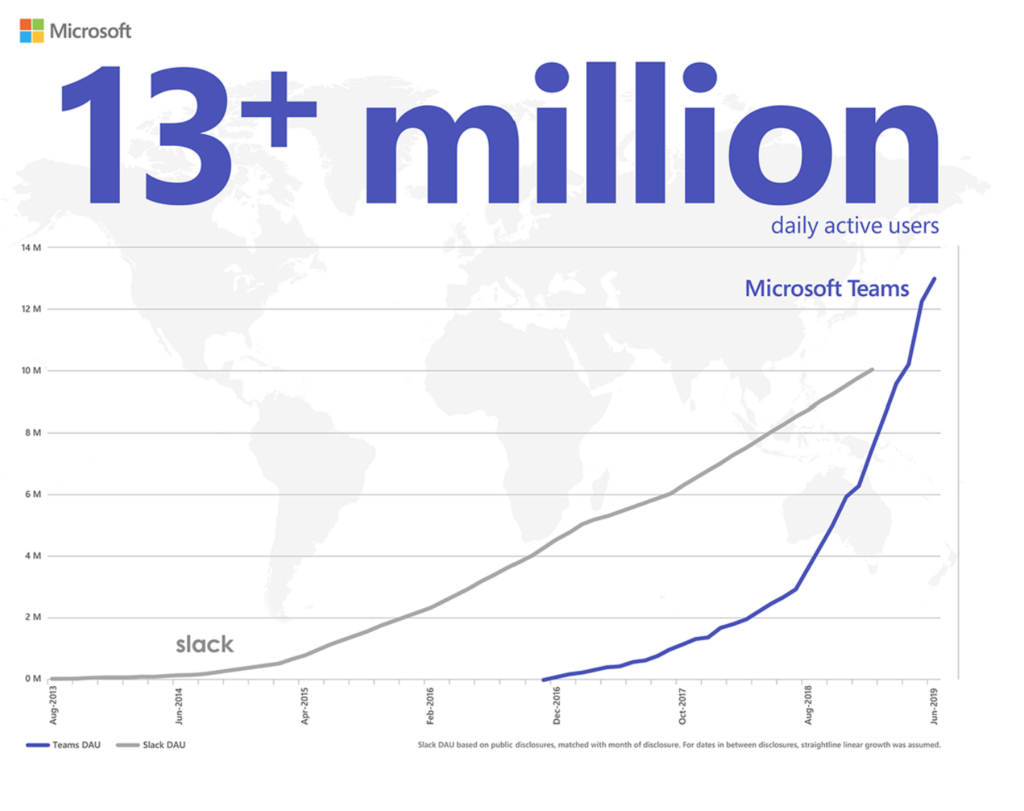This article was first published on ITK SECURITY.
Last update 2 years ago by Ruppelt PatrickReading time: 21 minutes
19 million voluntary Teams users in 500,000 companies? If you can believe it.
Recently I brought forward the article on this, How to stop Microsoft Teams from pushing itself to the forefront of every PC start-up. even though you neither want this piece of loadware nor have it installed, let alone have (knowingly) created an account for Microsoft Messenger. In this article, I share a few thoughts that come to mind.
Microsoft's rocky road to cross-platform software
Microsoft has been trying for decades to gain the upper hand in the field of Office software and also to conquer the market segment "Office Communication" - new German Unified Communications ("UC"). Somehow, however, this seems to be under a bad star, it just doesn't seem to work.
I see many reasons for this. I think one of Microsoft's main problems is that it is Microsoft. Of course, they only programme for Microsoft operating systems. Namely Windows.
Some Office applications have been ported to the Mac in the meantime. However, these have functioned properly never. Every Apple user who is forced to work with Word and Outlook will immediately confirm this. Most of the familiar functions from the Windows world are missing, and the software crashes several times a day.
If we now look at a universal communication system, such software only makes sense if it can actually be used universally. This means that it can be used not only by Windows 10 users but also by Mac OS X users and also on the iPhone, the tablet, the Android phone or perhaps even on Linux computers. Well, in a pinch, you should at least have access to it on a web portal.
As far as the integrated functions of such a solution are concerned, there are different views on what such software must be able to do. I would argue that the absolute minimum feature set should be:
- Chat system
- Video telephony
- File exchange
All functions must be possible within the company and with external participants. Beyond that, there are countless other conceivable possibilities, but these are first of all the most important and therefore also the mandatory ones. Everything else cannot be UC.
Ten unsuccessful years - from then until today
So what does one of the world's software market leaders and IT giants do when its own development department is incapable of developing a functioning cross-platform client? Let's just take a look at how badly Microsoft software works on Windows computers when it is first released. How will that end on third party operating systems? In the past we used to say, wait until the big service pack, then you might be able to use it halfway error-free. Today there are no more classic service packs, Microsoft simply releases the buggy alpha version straight away and makes improvements in the open (see my article on this from last year).
To understand the chaos behind Microsoft Teams and the marketing, political and economic problem of Microsoft, one has to look a little behind the historical scenes.
- It is the year 2010. Microsoft is taking its first steps in fast corporate communication. The product is called Microsoft Lync. Kind of a half chat client that can't do much, but telephony and even video telephony are supposed to be possible with it. Presence information and numerous meeting functions are also included.1). I worked as an external consultant for various companies at the time and my experience says otherwise. I don't know of a single company that has successfully mapped its telephony to Lync. Microsoft will contradict me and cite its own telephone system as a showcase example. But anyone who had to make regular phone calls with Microsoft at the time will agree with me: the call quality was poor; if a call was ever made and not lost in the noise or could not be set up at all. Not to mention the administration and the technical requirements. The only bad thing in this context is that free products for private users - above all Skype, of course - were technically decades ahead. Around 2000, Skype was already really good at what Microsoft was still trying to realise in 2010.2). Other products such as Facebook Messenger were already able to do in 2008 what Microsoft was still working on years later.3).
- Microsoft will also notice this at some point and act. In 2011, Microsoft buys the competing product Skype. 8.5 billion, the most expensive acquisition in the company's history. And this despite the fact that Skype was sold by its founders to ebay in 2005 for 2.6 billion US dollars and ebay had already parted with it again in 2009 for only 1.9 billion. The leap from 1.9 billion US dollars to 8.5 billion in just two years seems somewhat surreal. But Microsoft obviously had no choice, if it wanted to play in this market it had to make acquisitions. In addition, Microsoft's PC and smartphone businesses were collapsing, and the company hoped to gain new market potential through the acquisition, according to the argumentation at the time.4).
- Skype then results in 2015 the supposed new super product Skype for Business5). The main innovation is that it is now also available as a stand-alone product in Office 365. However, Skype for Business is not really popular either. Again, I can speak from my own experience with 6,000+ clients. Not even the chat function has ever worked reliably across companies. As an example, I went through this with the third level Microsoft support for a customer, only to receive the highly official statement from Microsoft that they don't know why it doesn't work and that this is a known, but non-trivial problem. Solution: Not a thing. "Take it as it is or use another program" was the motto.
- End 2016 Microsoft presents the new platform Teams ahead. Organisation, communication and collaboration are now the focus. The platform is intended to be an open office with chats, channels and groups.6). What is actually new about it now is a good question. Maybe the tile design from Windows 8. Malicious tongues would claim that we already had all this when I was still developing merchandise management and warehousing systems in Perl and AI bots in C at university at the end of the 90s. We had a so-called IRC client that could do all that, too. Not quite as colourful and flashing, but it could send messages and groups as well as connect to all kinds of external services. Well, somehow you have to remarket the old swamp.
- End 2017 the time had come, Microsoft announced: Teams will be the new all-rounder for corporate communication7). Now everything will be fine.
All good? User numbers say otherwise
How bitter it must be for a supposed market leader to be incapable of developing a functioning collaboration software for more than twenty years.
How tragic it must be when one then hopes to finally gain the upper hand by buying up the market leaders in the tens of billions - for possibly five times the actual value. But nobody wants to use the software. Those who want to, cannot manage a technically functioning implementation.
And then there is a competitor from the U.S.A. called Slack, which has developed a functioning client for all systems. Yes, Slack notifications even work on the iPhone and the native Slack client doesn't cause any problems on my Linux computers either.
In 2011, when Microsoft bought Skype, Slack had only 100,000 daily active users, a paltry figure in today's terms. Three years later, when Microsoft fails with Skype before Business, Slack already enjoys 1.25 million active users and earns 35 million US dollars annually from paying contract customers.8).
And today? According to the latest figures from April of this year, Slack probably had around 10 million active users.9). Since you have to download and install Slack like any other normal software if you want to use the software10)this information from the manufacturer should be halfway correct. After all, you first have to create an account, register for it, confirm your email address and company domain.11) etc. It's all quite quick, but you first have to create your company and your own employees, without which nothing works with Slack. So Slack also knew that there were around 10 million users actively using Slack in April.
At Microsoft, on the other hand, things look different. Since Teams has been included in Office 36512)Every Office 365 user also automatically has a Teams account.13). Whether someone has used it or ever installed the software is irrelevant. Because it is also possible to use Teams via the Office 365 portal, the software does not have to be installed for this. There is also no separate login for Teams, i.e. anyone who has just checked their emails online is potentially also a Microsoft Teams user.14).
So I would very seriously doubt Microsoft's figures. And anyway, for a long time they did not come close to Slack's figures, even with the "whitewashing" by Microsoft.
How to manipulate the stock market, market shares and user numbers
Microsoft then pulled the ripcord at the beginning of 2019. Slack wants to go public, and a rapid rise in the share price and enormous demand are expected for the IPO, which should prove to be the case. Slack has more and more - enthusiastic - customers and Microsoft Teams continues to scrape along the bottom despite billions in purchases and decades of effort.
Something has to happen. And it does happen.
Microsoft decides to, to automatically install the software product Microsoft Teams on all computers with Office 365 products without the knowledge and consent of the users, which is contrary to all good customs and legal principles.. The software is free of charge and an asset for any company with more than one worker, so everyone should be happy about it.15). At least that's how it looks from the customer's point of view, and there's no way to sugarcoat this statement.
What happens then is not surprising. The user numbers of Microsoft Teams skyrocket, while those of its main competitor Slack continue to grow just as steadily and reliably as they have done in the past years.


This graphic is directly from the Microsoft website and not a fake. The oversized bold "13+ million" stamp possibly illustrates the eagerness with which Microsoft has longed for this day. Already in 2018, the global roll-out began, presumably especially in the US. Since the beginning of 2019, Microsoft Teams has been activating automatically on all our customers in turn and there is nothing we can do about it. Within pretty much six months, all customers got Teams. Whether they wanted to or not, strictly speaking, every Office 365 customer has to thoroughly revise their processing directory and involve the works council.
You have to remind yourself of this. We are talking here about allegedly one million new corporate customers per month that Microsoft has been able to win over for its chat programme. The same number of corporate customers per month have technically implemented the solution. These are numbers that seem completely crazy.
But if Microsoft says that, then of course it must be so. After all, Microsoft does not spread lies. Never.
The press reports were not long in coming, reportedly there were already 19 million active users in July 201916). Of course, not without pointing out here and there that there is more data security for companies in the paid Teams variant that one cannot expect in the free variant.17). Ah yes, I don't need to understand the context now, do I? Is the team secure and compliant with the GDPR, or is it not?
Unfortunately, only a few editors still take a critical view of such Microsoft reports.18). Because again, all the numbers are chewed up by Microsoft and there is no insight at all into how they are even made up:
But these numbers, like all self-reported numbers should be taken cautiously. In this case, are both companies measuring the data the same way? This is always a concern, as it is in looking at social media platforms that use similar metrics." Wayne Kurtzman, research director at IDCComputerworld US, 12.07.201919)
The legality of this compulsory installation itself is a matter of considerable debate. However, this is not quite trivial, as many areas of law collide here.
First of all, we have the general DSGVO issue with Office 365. Whether this is all above board is something we can doubt in good conscience at least once.20).
Whether a forced installation in this way is okay is also open to question. There may be terms of use that state something like this, but whether they are valid in the present form and whether they even reflect what the admin and the user have to expect can also be seriously questioned.21).
And then there is the question of who at Microsoft has ever thought about the issue of labour law. Obviously no one, because Teams monitors working hours, shows the presence status of employees and much more. If things go really badly, all this even works for participants outside the company.22). Microsoft even actively advertises new monitoring and evaluation functions23)24).
I think one or two works councils will find this a feast for their eyes and, in this case, more than justified.25). As early as 2017, DGB legal experts argued that the use of Office 365 is subject to co-determination26) and Microsoft Teams makes this much worse in my opinion.
Want more manipulation?
In July of this year, one of the co-founders of Slack said that Teams was not a competitor to be feared.
At a business conference in Aspen, Colorado, Slack co-founder and CEO Stewart Butterfield spoke out. He said he was not concerned about the rapid growth of teams. "I don't think the numbers are a big threat," he told CNBC. Butterfield compared the situation to the search engine Bing: Microsoft has invested many billions of US dollars in it - so far in vain. "I don't know what their market share is today, maybe 9 percent or so," Butterfield said. (According to NetMarketShare, Bing's market share in the USA is currently 8.6 per cent.)heise, 07/201927)
Since then, however, things have changed.
The forced installation of teams on almost every company computer worldwide seems to have been accomplished.
The discontinuation of well-known on premise products is in full swing at Microsoft, so enterprise customers will soon only be left with Microsoft's cloud services for oh-so-important things such as storing the encryption keys of hard disks - which means you can't get away from Teams with that either.28).
And then allegedly internal Microsoft documents come to light again and again over a period of weeks, and of course they are widely publicised in the trade press:
Slack Free, Slack Standard and Slack Plus versions do not provide required controls to properly protect Microsoft Intellectual Property (IP). Existing users of these solutions should migrate chat history and files related to Microsoft business to Microsoft Teams, which offers the same features and integrated Office 365 apps, calling and meeting functionality. Learn more about the additional features that Teams can provide your workgroup. Slack Enterprise Grid version complies with Microsoft security requirements; however, we encourage use of Microsoft Teams rather than a competitive software.GeekWire, 21.6.201929)
In other words: Microsoft claims that Slack is insecure and that you should use Teams instead. All existing Slack users should please switch to Microsoft Teams as well.
That, too, is Microsoft's methodology. Anyone who believes that a product like Amazon Web Services can be used at Microsoft is mistaken. This is not welcome for competitive reasons, but because AWS allegedly does not meet Microsoft's governance requirements.30).
The fact that Microsoft, of all people, keeps claiming that software from competing companies is not secure - while Microsoft's own software is - is more than untrustworthy. I don't know of any other manufacturer in the world who has released such bad software with so many necessary security updates in the past 30 years.
And how does the stock market react to all this fraud and deceit?

Admittedly, the Slack share was thrown onto the market at the IPO completely overvalued. The 36 USD at which I myself bought Slack shares was not economically motivated but out of conviction. As was my exposure to Zoom Video, Twilio and other technology stocks. I had expected a certain devaluation. However, I did not expect my automatic stop loss to kick in within a few days and that I would now only own exactly 1 Slack share. In this sense, it was good for me that I got out so quickly, because there is no end in sight.
Yet Slack is actually not doing so badly.
For the 2020 financial year, the company now expects a turnover of between 603 and 610 million US dollars. Previously, it had targeted 590 to 600 million. Analyst estimates most recently averaged a good 611 million dollars.finanzen.net, 5.9.201931)
Now, it will be argued that Microsoft's methods did not bring down Slack's share price. Not alone, of course. Quite different reasons are cited again and again in stock market news. "Der Aktionär" has just summed it up very nicely:
- "Slack expects to post a loss of $0.08 to $0.07 per share for the current quarter. However, some analysts were already dreaming of profits."32). I don't think much needs to be said about that. Some analysts were dreaming. Good for them.
- "In addition, sales are expected to grow by only 47 per cent on average in Q3."33) Only by 47 percent. Yes, damn it. So no even bigger increase on previous years than this extremely solid growth?
- "The market is reluctant to see such weaknesses in Slack because with Microsoft Teams or Cisco's Webex Teams, the stock market newcomer is competing with groups that can build on a broad base of corporate customers."34) And that is exactly the point. Okay, Cisco has had UC customers for a long time. But Microsoft? The Redmond company was only able to build up a broad base of corporate customers through questionable means.
- "In order to assert itself on the market, Slack is rapidly increasing its marketing expenditure. These now account for 50 per cent of revenue. Total operating costs increased by 317 per cent in the past quarter."35) That is a real problem. How else is a newcomer like Slack supposed to prevail against the giant? Slack does not have the ability to install software on millions of computers around the world without the users' knowing consent.
And so this paper comes to the - from a shareholder's point of view understandable - conclusion:
In view of the rising costs and the cautious forecast, analysts doubt whether Slack will succeed in breaking even in the near future in the competition against Microsoft and Co. And rightly so. DER AKTIONÄR's advice remains unchanged: Keep your distance!Der Aktionär, 5.9.201936)
Too bad. It could have been something.
For me, at least, this has nothing to do with fair competition.
As always at the end of such a plain text article against big companies: just my two cents. That is to say, the information is only my personal opinion. My name is Patrick Ruppelt, and this is my opinion.
∞
Update 21.10.2019: So very gradually the big reporters are jumping on 😉 from a recent report by reporter Motley Fool37)https://www.fool.com/investing/2019/10/15/slack-fires-back-at-microsoft-on-user-metrics.aspx:
Slack (NYSE:WORK) investors were rattled over the summer when Microsoft (NASDAQ:MSFT) said that its competing Teams app had garnered 13 million daily active users (DAUs) - ahead of the 10 million DAUs that Slack had at the time. (...) Slack argues that DAUs can be a superficial metric, and that usage and engagement are what really matters. "Engagement is what makes Slack work - you can't transform a workplace if people aren't actually using the product," Elliott writes.Source: The Motley Fool, Slack Fires Back at Microsoft on User Metrics, report dated 15.10.201938)
∞






